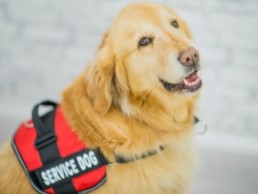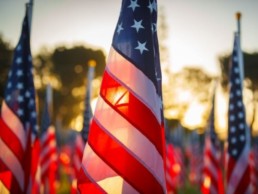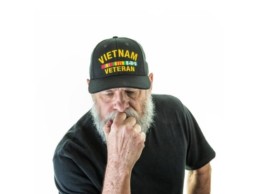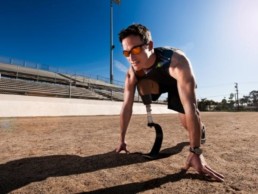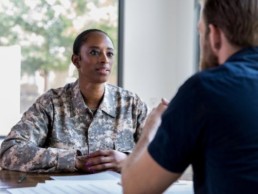Can We Talk About How Veteran Service Dogs Work Hard To Be More Than Just Man’s Best Friend?
Ever notice when you’re out at the gym, or the grocery store, or the train station,places you least expect to see an animal, you see a person walking with a dog? Well, your eyes aren’t deceiving you and these are not just any ordinary canines, they are actually incredibly trained service dogs. You likely won’t see the effects of what they do or how they help out their owner, but there is more to them than meets the eye. Service dogs assist veterans with different needs in a variety of ways and it is something that, as a veteran supporting community, we should talk about. They aren’t just there to keep company, but to help handlers with disabilities so that they can lead more independent lives.
The Best of the Best
Service dogs can help in the range of physical, sensory, psychiatric, intellectual, or even mental disabilities that a veteran can have. About 50% – 70% of dogs picked fail through service training. Dogs must be above average when it comes to their abilities, and this is only the very beginning of determining a worthy service dog. Service dogs in training must be able to exhibit a desire to work, a calm demeanor, high intelligence, and have a friendly and loving disposition. So, it takes more than a good nose to be a service dog.
Testimony
Veteran Toye Hickman is a service dog owner who shared her testimony about how her life has changed since she first got her service dog, as she deals with post-traumatic stress disorder, depression and anxiety. “He understands when my anxiety is going up. He’ll follow me around, he’ll pester me to get up and do something,” Hickman said. “If I’m having a down day, even though he’s a very active dog, he’ll lay right beside me and won’t leave my side.” Toye says her life changed when her service dog Bake entered it just two years ago.
Purple Heart Testimony / Clay the Service Dog
The Purple Heart Foundation believes that service dogs can truly help veterans, and that is why we offer this program to veterans. Watch retired veteran Jim Mirick, in his own words, detailing how much his service dog has helped him. He states, “He and I have such a bond together, he’s very tight with me, he’s irreplaceable to me.” Speaking of service dogs, our newest member to the Purple Heart Foundation family is Clay the service puppy, named after Purple Heart Recipient and former Purple Heart Foundation board member, Clayton Jones who passed in 2021. Clay is in the early stages of his nearly twenty four month training program, and from what we can tell he is determined and working hard through the process as a young student.
Conclusion
When the time comes, Clay will be matched with an honorably discharged veteran and their family, hopefully providing invaluable support while making a significant difference in a veterans’ life. Giving new meaning to the phrase Man’s best friend, our returning heroes, with their new companions, will be able to return towards the path of independence. Click here to learn more about our service dog program.
4 Ways to Give Back
There are a few days throughout the year when we think about or officially recognize veterans and service men and women. But there are ways to give back to current and former members of our military every day of the year.
Say thank you.
When you see a service man or woman in uniform, or a person wearing something that identifies them as a veteran, take a minute to say hello and thank you. You don’t need to make a big, dramatic gesture; just let them know you appreciate their service. If they feel like talking, take the time to listen to their stories.
Hire a vet.
Do you own a business? Consider hiring a veteran. You can work with the United States Department of Labor’s VETS Program, or similar nonprofit organization that helps vouch for and place qualified veterans in businesses.
Stay informed.
Only a fraction of U.S. citizens currently serve, and few Americans have personal contact with members of our military, causing a disconnect between the military and the civilian worlds. Take some time to get informed about the issues facing our troops and veterans. Follow veteran organizations on social media, and learn about how you can help.
Make a donation.
When you donate to the Purple Heart Foundation, your generous gift helps us to support veterans and their families during their transition from the battlefield to the home front.
Our programs and those to which we award grants support hundreds of thousands of our nation’s heroes. There are many ways you can make a tax-deductible donation.
- Visit our website and make a credit card donation.
- Call us at 888-414-4483 or complete the form to donate your vehicle.
- Schedule a pick-up to donate clothing or household goods.
- Simply text PURPLE to 20222 to make a $10.00 donation right now.
- Consider becoming a Purple Heart Legacy member, and leave a gift from your estate. Call us at 703-256-6139 to discuss your options.
We often get asked how we use your donations. Here is a snapshot. If you want more information, give us a call; we would be happy to share it with you.
We use your generous donations
- To help fund research and assistance that tackle the unseen wounds impacting veterans, things like Post Traumatic Stress (PTS), Traumatic Brain Injury (TBI); suicide, and sexual abuse
- To fund Purple Heart’s Service Officers, who are stationed throughout the country to work with veterans informing them about education opportunities, scholarships, disability compensation, employment training, hospitalization and rehabilitation benefits, pensions, and more
- To employ a full-time attorney dedicated to protecting the interests of wounded servicemen and women and presenting veterans’ claims before a court
Vietnam Veteran to High School History
We all wonder where life will take us, he never wondered, he knew. John Harrison, a sophomore student at North Carolina University, wanted to fly helicopters but the only way he was able to, was by joining the Army. Not many would jump at the idea of joining the military, but he did… just to fly helicopters. Growing up he had a great childhood, a loving family and no regrets. With a clear vision in mind and the love for helicopters in heart, he pressed on with the hopes of making a difference.
It didn’t take long for John to get through Basic Combat Training, pass all qualifications and tests at Ft. Polk, L.A. and confidently begin his service in the United States Army, something he had aspired to do for so long. The transition from civilian to soldier was not an easy one though; it was divided into three parts…
- “The RED phase” is the beginning of your training, to prepare you for what’s to come.
- “The WHITE phase” is where he got most of the physical and psychological strength.
- “The BLUE phase” taught him how to handle weapons.
During the first several months in the military, John really enjoyed his time with fellow soldiers and instructors who only had “Tough love” for him. Since he had prepared well for the Army he was in great shape to withstand just about anything, even though he recalls the weather being too hot. It was so unbearably hot in Vietnam that they would drink 4 to 5 gallons of water, every day.
Many would be surprised how John expresses his take on joining the army, but this experience changed his life, his points of view, and his whole being. In the military you can train and prepare as much as possible, but nothing is like experiencing the challenges and traumas of combat than real life. John went to Officer Candidate School later, where he became Airborne Rifle Platoon Leader and Company Executive Officer.
Not long after, his unit was deployed to Vietnam on a USNS (United States Naval Ship). John joked, that although his accommodations on that ship weren’t great, the food was the best part. Since the ship was old, they had to stop at an island in the Philippines for repairs. While on the island, many of them stayed late in a club and almost ended up getting killed! Then after leaving the island, they came across the end tag of a typhoon and many were having trouble keeping their food down.
Finally, they reached Vietnam. They were told they would be safe because they were being protected by South Korea. One of the scariest and most unexpected moments in Vietnam was the first time he got shot at while walking in the mountains with his platoon. John thought to himself that he had been around shooting ranges so it wouldn’t be such a big deal…but as they kept taking on fire, he felt dumbfounded, he didn’t react, he didn’t really know what to do in that moment. The firefights in Vietnam were nothing like they had trained for.
John lasted 4 years in the Army, and said that it was nothing like he had expected. The military can train you so much, but you will never be completely ready to fight when it comes down to it. He was awarded the Purple Heart medal, because he was wounded during his service in Vietnam. He is thankful every day for not ever being captured as a prisoner of war (POW) and for being able to come home to his family. John retired from the military and went back to school to study Law. He became a well-known attorney and realtor in the Washington-Metropolitan Area. Later he went on to teach law at Bishop Denis J. O’Connell High School where he said he truly enjoyed his time with his students and learned a lot from their different opinions.
Now John enjoys his time traveling, being at home and just enjoying life. He has published two (2) books, in which he narrates his life experiences in Vietnam. From one’s first impression of John though, you wouldn’t think he was a veteran or picture him in the dangerous settings he described to me today. One thing is for sure though, John Harrison is and always will be, “Army Strong”.
Servicemen and Service Dogs: A Life Saving Connection
Our servicemen and women have to restart their lives upon returning home from battle. These new challenges can present circumstances far different from those of war. Facing these challenges head on can be daunting for many. Easing back into society can tough, especially for those who suffer from Post-Traumatic Stress (PTS) and Traumatic Brain Injury (TBI). According to the Veterans Administration (VA), between 11-20% of veterans during Operations Iraqi Freedom (OIF) and Enduring Freedom (OEF) have been diagnosed with PTS in a given year.
There are a variety of ways to ensure that transition is as smooth as possible. One of those methods is pairing a Veteran with a service dog. Suffering from PTS can leave an individual feeling isolated from family and friends. Depression and other emotional disorders can surface as well. The method of service dogs is to provide the veteran with a companion trained to help them with basic needs. However, the animal is indirectly re-teaching the veteran how to care for someone, using emotions as communication, and even how to love.
“We think pet dogs, therapy animals and service animals all have a role to play in peoples’ health and veterans’ health. This is all good news. A cold nose is a powerful motivation to get up in the morning,” said Stave Feldman, executive director of the Human Animal Bond Research Institute Foundation. Mr. Feldman discussed studies between the animals and veterans to The Military Times in a recent article.
“He brought me back from the brink,” said Veteran Colonel Roger Lintz, (US Army – Retired) of his Service Dog – Niles. Living with PTS does take time to accept that life may not be the same. This veteran, who honorably served his country, was able to find true companionship with his new four legged friend. Niles was able to help him with remedial tasks around the house and would wake him from nightmares. These nightmares and other issues with PTS nearly became too much to handle. Col. Lintz believes that his companion saved his life when suicidal thoughts started to cloud his mind. Watch the full interview:
The American Psychology Association and The Society Military Psychology have found that this alternative method could help nearly 40% of veterans. Especially those who do not show signs of improvement after participating in treatments such as prolonged exposure (PE) and cognitive processing therapy (CPT), which are considered the “gold standard” for treating PTS.
Maj. Todd Olsen had participated in multiple tours of duty since enlisting in the Army in 1989. However, coming back after his last mission sent his life into a tailspin. He was suffering from multiple symptoms of PTS, rebuilding a relationship with his two boys, and filing for divorce from his wife.
Some servicemen and women will attend the actual trainings with their service dog. They get to watch them go through obstacle courses, learn commands, and how to save lives. This, in a way, gives the veteran a sense of purpose again. Their life and bond matter as much to the service dog as the service dog means to them.
Maj. Todd Olsen of Pennsylvania told The Daily Progress that, “It’s not so much training the dog, it’s training the veteran and then pairing them up together. So we weren’t teaching them basic obedience, we were learning the commands and the dogs were learning how we give the commands.”
There have been few in-depth studies about the dynamic between a service dog and PTS. However, The Veterans Administration believes that veterans can experience some needed benefits by owning an animal or being paired with a service dog. The VA also counsels that veterans should speak with their doctor and family before applying for a service dog.
What are the emotional benefits of having a dog?
Dogs can make great pets. Having a dog as a pet can benefit anyone who likes dogs, including people with PTS. For example, dogs:
-
Help bring out feelings of love
-
Do things that are different from natural dog behavior
-
Do things that the handler (dog owner) cannot do because of a disability
-
Learn to work with the new handler in ways that help manage the owner’s disability
-
Are good companions
-
Take orders well when trained. This can be very comfortable for a Servicemember or Veteran who was used to giving orders in the military
-
Are fun and can help reduce stress
-
Are a good reason to get out of the house, spend time outdoors, and meet new people
(Source: The Veterans Administration)
Maj. Todd Olsen continues his transition into “civilian life” by working with his service dog and attending yoga classes. He says, “With the yoga for veterans and the dog, and continuing treatment at the VA, it’s putting me back together.”
The Purple Heart Foundation has provided funds to service dog programs totaling $75,000 over the years. The Purple Heart Foundation remains committed to assisting veterans in all aspects of their lives, including service dog programs, other rehabilitative programs, and disability benefits. You can show your support for these brave men and women who have sacrificed so much for our country by making a one-time or monthly pledge to ensure veterans continue to get the support and benefits they deserve by clicking here.
Paralympics Rio 2016
This year’s Olympic games in Rio de Janiero, Brazil was full of exceeded expectations, excitement, and more. In addition to Simone Biles, Michael Phelps, and other Olympians, there were 19 servicemen and women who qualified for a position on the Team USA roster–15 active-duty personnel, 2 veterans, 1 Navy civilian, and 1 incoming midshipman to the Naval Academy, including Spc. Dan Lowe, Regine Tugade, and 2nd. Lt. Sam Hendricks.
Out of all 121 medals, Army Specialist Paul Chelimo received one of the 37 silver medals awarded. Chelimo, who was born in Kenya, won the silver in the men’s 5,000 meter run. After the race, he was informed by a television reporter that he was disqualified from the race for infringement in another athlete’s lane, but the ruling was later overturned. Chelimo ran his best time of 13 minutes, 3.94 seconds, right behind Great Britain’s Mo Farah.
Chelimo was a part of the U.S. Army World Class Athlete Program, which he credits for being the reason he was able to compete in Rio, “I’m only here because of these Army Soldiers,” Fanning said. “That’s the reason I’m part of this delegation. But it was fun for the entire delegation to have an extra reason to cheer, not just for the United States but for the Army, so they were screaming loudly for him: ‘Who’s your Soldier? Who’s your Soldier?’”
Chelimo’s next tour will not be overseas with fellow soldiers, but throughout the United States as a trainer with the World Class Athlete Program, inspiring the youth in this country to follow their dreams.
With the Olympics at a close, it’s time to turn our attention to the 15th Paralympic Games, which will also be held in Rio. Of the Paralympians competing, there are 20 soldiers, six Marines, three sailors, and one airman across the 23 sports being showcased.
In addition to Brad Synder, a sailor who lost his eyesight in Afghanistan and holds the world record for the blind 100-meter freestyle, there is Anthony McDaniel competing in Para Rugby and Elizabeth Marks, competing in Para Swimming, among other athletes and veterans. McDaniel lost his legs and left hand in 2010 from an improvised explosive device while serving as a Marine in Afghanistan and Marks suffered severe hip injuries while an Army combat medic in Iraq in 2010, which left her with no sensation in her left leg.
McDaniel said back in 2014 that adaptive sports helped give him a sense of tranquility after spending more than a year in rehab following the IED explosion in August 2010, “It’s just been helping me stay focused and positive,” McDaniel said. “It keeps me out and active every day.”
Marks told ESPN that the medals she earns in her competitions are not the end game–to her, the process of competing is more gratifying and thinks back to helping others during her time as a combat medic, “When I step onto the blocks, I never think, ‘I want to win,’” she says. “I think, ‘I want to pour all of myself into this race because there are people who can’t physically, mentally or emotionally, do that.’ So it’s my way of performing for them.”
The Paralympics are now days away from the start of the 15th Paralympics. It runs from September 7-18. We salute these servicemen and women and are excited to see how they compete and represent the United States and their respective military branches.
The Purple Heart Foundation is committed to assisting not just the Veterans of the Paralympics, but all veterans who have served our country. Show your support for these brave men and women by making a one-time or monthly pledge to ensure Veterans continue to get the support and benefits they deserve by clicking here.
From Deployment to Employment: How to Adjust to a Civilian Work Environment
Transitioning from military service to a rewarding career can feel like a daunting undertaking. The work environment and requirements are usually pretty different. What made you successful in the military may not work as well or could even be counterproductive in civilian life.
Many veterans have trouble coping with this adjustment for several reasons:
- The lower stakes lead to boredom.
- The lack of straightforward rules and missions can cause confusion and anxiety.
- Survival behaviors learned during combat, like a flight or fight response, are counter-productive in a work environment.
- Stress and painful memories from deployment can make it difficult to concentrate and remember important information.
- Military skills don’t always translate to a new work environment.
But the structure and discipline you mastered during your military service can also help you succeed in a civilian work environment. Here are a few things to remember:
Focus on your health.
- See a doctor when necessary and only take medications as prescribed.
- Stay away from unhealthy foods (high fat, high sugar).
- Don’t use non-prescribed drugs or drink alcohol excessively.
- Keep a routine—get enough sleep, exercise regularly, eat at the same time each day.
Learn and practice communication skills.
- Maintain polite and friendly communication with co-workers
- Ask for help about talking about deployment with colleagues
- Learn the appropriate ways to handle conflict and criticism, taking into account the culture of your workplace.
Practice organization
- Keep you workspace neat
- Make task lists
- If you have trouble staying focused, write your thoughts in a journal or notebook.
Create your own structure
- Assess your values and make a list.
- Determine the ways your job fits with your values.
- To identify your values, ask yourself questions like:
- What kind of an employee do I want to be? Hard-working? Dependable? A trustworthy officer?
- What parts of work are important to me? Using and building my skills? Fixing problems? Leading a team of people?
- What do I like about my current job? The way people treat each other? The feeling of accomplishment? Good benefits?
- How does this job fit with serving my country?
- Set long-term goals, like an ideal future position or promotion, and then set short-term goals that will help you achieve them.
- Stay current on training and the technology used in your field.
If you are looking for some training, check out Purple Heart’s Veterans Vocational Technical Institute.
If you want to go back to school and complete an undergraduate degree, learn about Purple Heart scholarships.
For career counseling or other services, find a National Service Officer near you.
Resources:
TurboTAP (Transition Assistance Program)
Veterans’ Employment and Training Services
Military.com Veteran Employment Center

